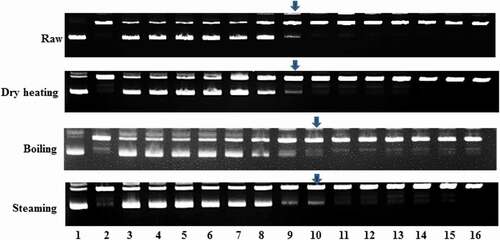Figures & data
Table 1. Total phenolic, tannin, and flavonoid content of raw and processed bambara groundnut seeds.
Table 2. FRAP, metal chelating, DPPH, and ABTS activity of raw and processed bambara groundnut seeds.
Table 3. The correlation between total phenolic, tannin, and flavonoid content and antioxidant activity (FRAP and 1/EC50 of metal chelating, DPPH, and ABTS) of bambara groundnut seeds.
Figure 1. DNA protection of raw and processed bambara groundnut seeds. Lane 1 is pBR 322 plasmid DNA. Lane 2 is pBR 322 plasmid DNA + AAPH. Lanes 3–16 are pBR 322 plasmid DNA + AAPH + bambara groundnut seed extract. The bambara groundnut seed extract concentrations of lanes 3–16 are 10,000, 5,000, 2,000, 1,000, 500, 300, 100, 50, 10, 5, 1, 0.5, 0.1, and 0.05 µg/mL, respectively. The arrows indicate the minimum concentration of extract that can protect DNA against oxidative damage.

